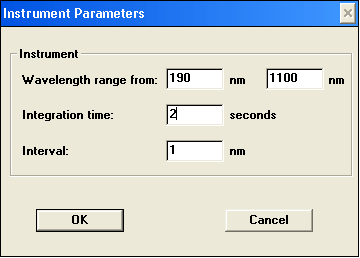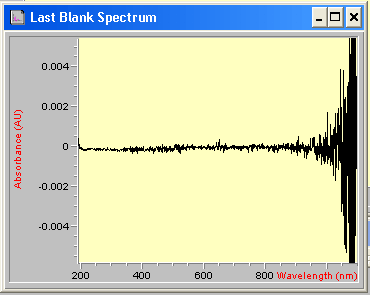|
 Simple spectral measurements can be done in either Standard or Advanced system modes. Simple spectral measurements can be done in either Standard or Advanced system modes.
Examples on this page are for the Standard mode. Windows and dialogs in other modes will look different, alhough their meaning does not change.
Setting parameters
 Once the systems is turned on and given enough time to stabilize light output, you are ready to measure spectra. First, open Instrument parameters dialog from main menu and check settings. Once the systems is turned on and given enough time to stabilize light output, you are ready to measure spectra. First, open Instrument parameters dialog from main menu and check settings.
Whenever HPSpec measures spectra, it acquires entire wavelength range determined by the hardware. While you can limit wavelength range and interval from this dialog, there is no benefit of reduced range. Unfortunately it is no faster to measure 100 nm span every 5 nm as opposed to 910 nm span every 1 nm. It is therefore recommended to measure the entire range at 1 nm intervals and discard unused data in post-processing.
Integration time, however, affects measured spectra. In practical terms, the longer you measure, the lower is noise in the resulting spectra. In most cases 1-2 sec is sufficient. For best S/N ratio integration time can be as long as 20-30 sec. In cases when one needs to follow rapid changes in the sample, integration can be as short as 0.1 sec. |
Blank or reference
 Chemstation presents data in the absorption form: A=-log10(I/I0). Higher absorption values mean more light is absorbed by the sample and less light makes it through. Lower absorption values mean that sample is more transparent. For sample that absorbs no more and no less light than the reference, absorption equals zero. Intensity of absorption is described by Lambert-Beer law. Chemstation presents data in the absorption form: A=-log10(I/I0). Higher absorption values mean more light is absorbed by the sample and less light makes it through. Lower absorption values mean that sample is more transparent. For sample that absorbs no more and no less light than the reference, absorption equals zero. Intensity of absorption is described by Lambert-Beer law.
Before absorption of any sample can be measured, a blank measurement (I0) needs to be taken. Blank is typically measured using all components of the sample except for the analyte, or the substance that is being analyzed. If you are interested in the spectrum of a compound dissolved in a liquid, blank should be measured using the solvent of the same composition less sample. For best results use the same cuvette that you will measure sample in.
Once blank sample is placed in the sample compartment, click Blank button in Chemstation. Spectrometer will measure intensity of light transmitted through blank without analyte and bring up Last Blank Spectrum window. This window can be closed - it is for information only.
|
Measuring samples
After blank spectrum is measured and stored, absorption of a sample can be calculated and Sample button is enabled in Chemstation software. To measure spectrum of the sample, replace blank sample with analyte sample and click Sample button. Duration of measurement will depend on the settings in Parameters dialog and typically will be 2-3 fold longer than integration time.
Upon completion of measurement a spectrum will be displayed in the Sample Spectra window and a line will be appended at the end of the list in the Sample/Result Table.

Give sample a short, but descriptive name. You may remember now what did sample #12 contain, but you are bound to have hard time figuring it out next week.
As long as you sample medium does not change you can make as many spectral measurements as necessary without re-measuring blank. For best results and because of slow drifts of baseline, however, it is recommended to re-measure blank periodically and before every critical measurement.

|
What's next?
After measurements are complete, proceed to save data in to a file and to export data for analysis. |
|



